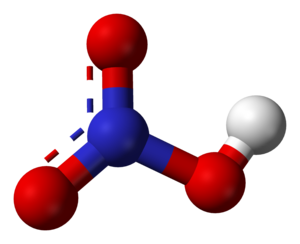Chemistry Notes-3
Image via Wikipedia
1. Ammonia is manufactured by the Haber Process
2. Full Name of TNT, an explosive is Trinitrotoluene
3. Trinitrophenol, which is used as an explosive and antiseptic is also known as Picric Acid.
4. Nessler’s Reagent is used for the test of Ammonia and Ammonium Salt. It gives brown precipitates
5. Nitric Acid ( HNO3) is manufactured by Electric Arc Process.
6. The process of Petroleum refining is called as a fractional distillation
7. There are various products having different boiling points which are obtained during fractional distillation. At a boiling point of 30 to 70 celcius there is Petroleum Ether which is used as solvent for drycleaning. At a boiling point of 70 to 120 degrees celcius, there is Petrol or gasoline which is used as a motor fuel and general solvent. At a boiling point of 120 to 150 degrees celcius, there is Benzoline which is also a solvent. Then there is Kerosene at 150 to 300 degrees celcius which is used as an illuminant and as a fuel. And Finally above 300 degrees celcius as boiling point, we have Lubricating oil, vasaline and paraffin wax which are used as lubricant, grease and wax.
8. Petrol is obtained by a process called cracking. In this process kerosene and crude oil are broken up into low boiling point hydrocarbons such as Octane and Heptane.
9. To prevent knocking in petrol engine, an antiknock agent such as Tetraethyl lead is added. Now in lead free oils it is not used as it also harms catalytic converters.
10. Iron commonly have three forms, first form which is the crudest form is cast iron containing 2 to 5 percent carbon. Then there is steel which has 0.15 to 1.5% of carbon. Wrought iron is the purest form of iron having 0.12 to 0.25 percent of carbon.
11. On exposure to moist air, in the presence of carbon dioxide, iron is converted into brown hydrated iron oxide ( Fe2O3. 10 H2O). This process is called rusting.
12. Stainless steel contains 13% chromium.
13. Acids are generally sour, turn blue litmus red and generally give hydrogen with metals.
14. An acid is a substance which furnishes H+ ion on dissolving with water. It is proton donor and an electon acceptor.
15. Bases react with Acids to produce salt and water. They turn red litmus blue. They are also called alkalies eg. NaOH.
16. A base is defined as proton acceptor and an electron donor.
17. pH is negative logarithm of H ions. pH of neutral solutions is 7. For acidic solutions, pH is between 0 and 7 and for alkaline solutions it is between 7-14.
18. Metals occur in nature as chemical compounds called minerals. If these minerals are used as the starting material for extracting the metal, they are called ores.

![Reblog this post [with Zemanta]](http://img.zemanta.com/reblog_e.png?x-id=6a71076a-70ef-47eb-8a64-a596ec39c451)
1 comment:
Great job!
Post a Comment